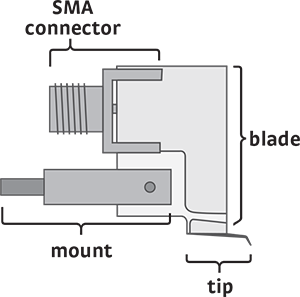ZN50R DC/RF probes
 Robust and versatile ZN50R probes are ideal for DC biasing, low/high-frequency measurements, low noise shielded, and low-leakage guarded measurements. The ZN50 probe mount incorporates a pair of copper braids (not shown below) that anchor to the sample
stage to cool the probe. An SMA connector is mounted directly to the alumina ceramic blade with a 50 Ω stripline routed to the probe contact.
Robust and versatile ZN50R probes are ideal for DC biasing, low/high-frequency measurements, low noise shielded, and low-leakage guarded measurements. The ZN50 probe mount incorporates a pair of copper braids (not shown below) that anchor to the sample
stage to cool the probe. An SMA connector is mounted directly to the alumina ceramic blade with a 50 Ω stripline routed to the probe contact.
| Probe P/N | Tip material | Tip radius (µm) |
| ZN50R-03-W | Tungsten | 3 |
| ZN50R-10-W | 10 |
| ZN50R-25-W | 25 |
| ZN50R-03-BECU | BeCu | 3 |
| ZN50R-10-BECU | 10 |
| ZN50R-25-BECU | 25 |
| ZN50R-100-BECU | 100 |
| ZN50R-200-BECU | 200 |
| Probe tip material | Description | Application | Conductivity | Contact resistance | Lifetime |
| Tungsten (W) | General purpose; durable | Good for varied surfaces; piercing oxide layers | Good | Low | Best |
| Beryllium copper (BeCu) | General purpose; low contact resistance | Typical gold contact landing pads | Better | Lower | Good |
| For over 25 years, the ZN50R probe has been the cryogenic probe industry standard. Originally designed by Eric Swartz of Desert Cryogenics, the ZN50R probe design is optimized for performance from 4 K up to 675 K. Simple needle probes common in room temperature probe stations transition from the signal cable directly to the probe tip with no mechanism for blocking heat flowing along with the electrical signal. Through a novel design, the ZN50R probe solves this dilemma. The probe transitions the signal from the signal cable to a temperature-stable ceramic “blade” that is cooled by the probe mount prior to transitioning to the probe tip. The ceramic material is specifically chosen for its temperature and electrical stability. This design provides key thermal cooling of the probe tip and blocks unwanted heat to the sample. |
 Robust and versatile ZN50R probes are ideal for DC biasing, low/high-frequency measurements, low noise shielded, and low-leakage guarded measurements. The ZN50 probe mount incorporates a pair of copper braids (not shown below) that anchor to the sample
stage to cool the probe. An SMA connector is mounted directly to the alumina ceramic blade with a 50 Ω stripline routed to the probe contact.
Robust and versatile ZN50R probes are ideal for DC biasing, low/high-frequency measurements, low noise shielded, and low-leakage guarded measurements. The ZN50 probe mount incorporates a pair of copper braids (not shown below) that anchor to the sample
stage to cool the probe. An SMA connector is mounted directly to the alumina ceramic blade with a 50 Ω stripline routed to the probe contact.





